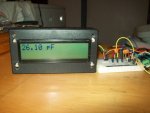Count maybe misunderstanding
- Thread starter Svejk
- Start date
hippy
Ex-Staff (retired)
One simplistic view is, COUNT will count the number of low-to-high transitions of a signal during the time period specified.
I presume you are counting on one PICAXE a signal put out from another PICAXE using PWMOUT. Getting half the count of the frequency suggests not counting for a full second or an operating speed mismatch of PICAXE, say the PICAXE doing PWMOUT at 4MHz, that counting at 8MHz.
Which PICAXE's are you using ?
I presume you are counting on one PICAXE a signal put out from another PICAXE using PWMOUT. Getting half the count of the frequency suggests not counting for a full second or an operating speed mismatch of PICAXE, say the PICAXE doing PWMOUT at 4MHz, that counting at 8MHz.
Which PICAXE's are you using ?
Mycroft2152
Senior Member
Hippy,One simplistic view is, COUNT will count the number of low-to-high transitions of a signal during the time period specified.
I presume you are counting on one PICAXE a signal put out from another PICAXE using PWMOUT. Getting half the count of the frequency suggests not counting for a full second or an operating speed mismatch of PICAXE, say the PICAXE doing PWMOUT at 4MHz, that counting at 8MHz.
Will you explain the reasons behind the count difference at different processor speeds.
Myc
hippy
Ex-Staff (retired)
SetFreq M4 : Count 0, 1000, w1
SetFreq M8 : Count 0, 1000, w2
In the first case the 1000 counts over 1000ms, in the second the time's speeded up two-fold so the time counted for is just 500ms. The following are all equivalents ...
SetFreq M2 : Count 0, 500, w0
SetFreq M4 : Count 0, 1000, w1
SetFreq M8 : Count 0, 2000, w2
SetFreq M8 : Count 0, 1000, w2
In the first case the 1000 counts over 1000ms, in the second the time's speeded up two-fold so the time counted for is just 500ms. The following are all equivalents ...
SetFreq M2 : Count 0, 500, w0
SetFreq M4 : Count 0, 1000, w1
SetFreq M8 : Count 0, 2000, w2
Mycroft2152
Senior Member
That makes sense.
Therefore COUNT has to be adjusted for any increased processor speed.
Therefore COUNT has to be adjusted for any increased processor speed.
hippy
Ex-Staff (retired)
Accuracy should be improved using X1's or X2's and crystals. You need them at both ends to get close to accurate results. There are still potential inaccuracies in that the count period is not perfect.
#Picaxe 08M
#Terminal 4800
PwmOut 2, 99, 200 ' 10kHz
Do
Count 3, 1000, w0 ' 1s sample
SerTxd( #w0, " ")
Loop
Gave me ...
10010 10010 10009 10009 10009 10009 10009 10010 10010 10010
10009 10009 10009 10009 10009 10010 10010 10010 10009 10009
10009 10009 10009 10009 10010 10010 10010 10009 10009 10009
Running with a 28X2 at 32MHz from crystal and PLL, 40kHz ...
#Picaxe 28X2
#Terminal 38400
SetFreq EM32
PwmOut C.1, 199, 400 ' 40kHz
Do
Count C.0, 8000, w0 ' 1s sample
SerTxd( #w0, " ")
Loop
Gave ...
40040 40040 40040 40040 40040 40040 40040 40040 40040 40039
40039 40039 40040 40040 40040 40040 40040 40040 40040 40040
40040 40040 40040 40040 40040 40040 40040 40040 40040 40040
#Picaxe 08M
#Terminal 4800
PwmOut 2, 99, 200 ' 10kHz
Do
Count 3, 1000, w0 ' 1s sample
SerTxd( #w0, " ")
Loop
Gave me ...
10010 10010 10009 10009 10009 10009 10009 10010 10010 10010
10009 10009 10009 10009 10009 10010 10010 10010 10009 10009
10009 10009 10009 10009 10010 10010 10010 10009 10009 10009
Running with a 28X2 at 32MHz from crystal and PLL, 40kHz ...
#Picaxe 28X2
#Terminal 38400
SetFreq EM32
PwmOut C.1, 199, 400 ' 40kHz
Do
Count C.0, 8000, w0 ' 1s sample
SerTxd( #w0, " ")
Loop
Gave ...
40040 40040 40040 40040 40040 40040 40040 40040 40040 40039
40039 40039 40040 40040 40040 40040 40040 40040 40040 40040
40040 40040 40040 40040 40040 40040 40040 40040 40040 40040
hippy
Ex-Staff (retired)
More than adequate in most cases I would guess. The variance of one is because the sample period cannot be perfect and thus starting between pulses or on a pulse can give off by one results. The overall discrepancy likely arises because time is really a 16-bit countdown on an 8-bit processor with varying instruction timing on conditional jumps, thus the time counting down stretches by a few microseconds occasionally and the sample period becomes slightly too long. That's not easy to overcome because adding instructions to compensate reduces the maximum frequency that can be counted quite drastically.
I've noted that down, sir! And I promise not to ask any questions between 2and 6:30 am.Remember to treble-check before your next post
Learning from mistakes
Following my mishap with count I figured that I can make a capacitor meter using a simple op amp oscilator and counting the frequency
Attached is a photo of a 27pF measured. I'll tidy up the code and schematic, maybe extend the range and post it in finished projects.
Following my mishap with count I figured that I can make a capacitor meter using a simple op amp oscilator and counting the frequency
Attached is a photo of a 27pF measured. I'll tidy up the code and schematic, maybe extend the range and post it in finished projects.
Attachments
-
49.2 KB Views: 22

